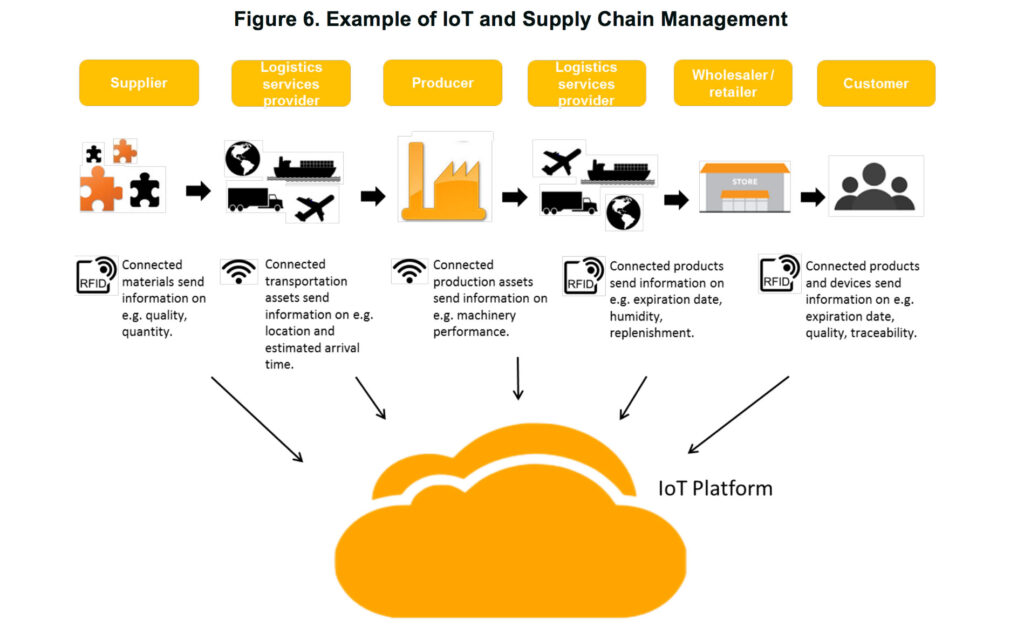Why a Connected Supply Chain is Vital for Logistics and Quality Teams in the Food and Beverage Industry.
Why Supply Chain Connectivity?
Supply chain connectivity is defined as the seamless flow of materials, information, and financial resources along the supply chain, enabled by two factors: information systems connectivity and physical connectivity according to a paper by Auustina Calatayud for Inter-American Development Bank (IDB).

Source: Auustina Calatayud for Inter-American Development Bank (IDB).
Though it accounts for just one link in the chain; more and more, the complete visibility of the product from dock to dock is being monitored by a connected supply chain and for good reason. There are billions of dollars to be saved in losses during storage and shipping.
Supply Chain Connectivity in the Food Industry
For the food industry, this is of particular importance. One report by a food organization in Europe suggested that loss accounts for on average, 15% of annual production volume with a whopping 74% of this loss due to inefficiencies in logistics and production processes.
“Together with the use of IoT and Big Data, real-time information sensor-generated information can be encrypted, validated, and shared among supply chain partners to ensure, for instance, that the temperature, humidity, and quality conditions of materials and products have been unaltered in their flow thorough the supply chain,” explains Calatayud.
For instance, in the food and beverage industry, cold-chain monitoring is an easy application to grasp. An entire load can be lost if the container or trailer gets too warm at any given point in the chain. However, the root cause of damage can be much more than temperature change.
Other applications can include optimization of the transportation process, risk mitigation, traceability for quality control or even compliance.
Applications for Transportation and Logistics
Through the improvements in wireless cloud-enabled sensors that are allowing data analysis and even real-time alerts, for those involved in the logistics of moving goods, optimizing routes, analyzing vehicle performance, studying driver behavior, warehouse optimization, and location tracking are just a handful of the benefits for logistics teams.
Add to that, the visibility of containers from dock to dock including time and location of any shocks, shifts or pressures occurring during production through transportation, and you have a formula for a new road to success.
“Based on reliable data, supply chain managers will be able to better handle incidents, mitigate risk and loss, as well as optimize their operation; all the while knowing that they are being informed with accurate, unbiased information.”
According to Deloitte in their Shipping Smarter report, other common applications for logistics supply connectivity include capacity sensing, planning and reporting, route optimization, energy management and fault detection and resolution. The common applications for logistics demand include environment monitoring and management, threat detection and prevention and real-time traceability.
The Transformative Value of a Connected Supply Chain
A true connected supply chain in our current time involves both the supplier and shipper being connected as well as any cross dock, intermodal or transmodal partners along the way, and of course, the customer. Complete connectivity is happening on a global scale and allowing the best of improvements. The relationships between partners are definitely being seen as win-win.
As noted in the IDB report, “According to recent studies, companies that have invested in these technologies for their supply chain management have cut up to 30 percent out of inventory, increased the average fill rate by up to 7 percent, and raised their revenue by up to 15 percent (DHL, 2015).”
“According to recent studies, companies that have invested in these technologies for their supply chain management have cut up to 30 percent out of inventory, increased the average fill rate by up to 7 percent, and raised their revenue by up to 15 percent (DHL, 2015).”






